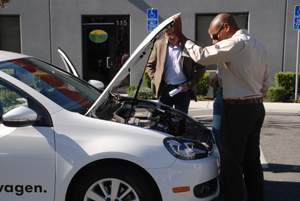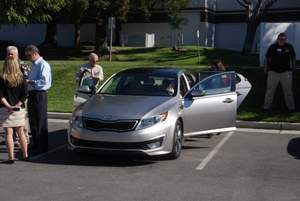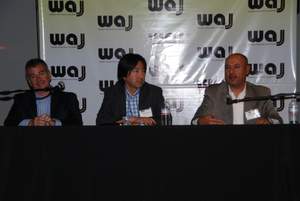What’s Coming in Cars; Some Is Already Here

The fifth annual “Future Cars, Future Technology” event put on by the Western Automotive Journalists’ association on Oct. 17, offered several glimpses of the future. You could drive a prototype electric Volkswagen Golf, due to go on sale next year, or hear an executive from the California Air Resources Board predict that future pickup trucks would be powered by fuel cells. Or you could hear that according to Stanford’s Dr. Sven Beiker we don’t really know what distraction is so figuring out how to deal with it is going to be more complicated than simply banning texting.
The symposium, sponsored by Club Auto Sport, Mazda Raceway Laguna Seca, Fiat, Ford, General Motors, Kia, Mitsubishi and Volkswagen, started with a hands-on view of the divergent paths that the auto world is currently taking. In the parking lot available for driving evaluations were five different approaches to the automotive future:
- Pure electric cars, which were represented by the prototype e-Golf, Chevy Spark EV, Fiat 500e and Ford Focus Electric.
- Plug-in hybrids represented by the Ford C-Max Energi.
- Hybrids were represented by the Kia Optima Hybrid and VW Jetta Hybrid.

The Kia Optima Hybrid attracted a crowd - Diesels representing by a Ram 1500 EcoDiesel, VW Passat TDI and a second Passat TDI running on Solazyme’s SolaDiesel renewable diesel. The latter showcases a biofuel path that would replace petroleum diesel or gasoline with a bio-based fuel that would present a greener carbon footprint as well as reduced emissions.
- Advanced technology gasoline vehicles were represented by the 2014 Mitsubishi Outlander, which, in addition to offering more than 30 mpg in a seven-passenger SUV, has adaptive cruise control, lane departure warning and forward collision mitigation. The latter technology will alert the driver of an impending crash and apply the brakes if the driver fails to.
- Missing from the collection of cars and trucks was a fuel cell vehicle. Although that technology path was not present, Toyota and other manufacturers have said they would have vehicles on sales by 2015.
Automotive Electronics/Smartphones & Cars
The technology suite found in the Mitsubishi in the ride-and-drive provided a good segue to the first panel of program, which featured Dr. Beiker and Ford Silicon Valley Lab leader T.J. Giuli discussing new electronic systems in automobiles and whether they are making vehicles safer or less safe by introducing new sources of distraction.
The two agreed that the path forward with electronics was not clear, which consumers expecting more connectivity and technology in cars and automakers challenged to keep up because of the short product cycle for electronics compared to automobiles. “How do we keep up?” Giuli mused. But he added that new features such as AppLink promise to bring smartphone applications seamlessly in the car. Beiker suggested that maybe it was a matter of car companies needing to “explain to consumers what they need” because the market pull at the present was stronger than the technology push.
The vision of an autonomous, self-driving car, while technically feasible now, is still at least a decade away from practical use, according to the panelists.
Zero/Near-zero Emission Cars
Later, discussion turned to powertrains and fuels of the future with Dr. Alberto Ayala, deputy executive officer of the California Air Resources Board (CARB); Dave Barthmuss, group manager, environment, energy & policy communications for General Motors; and Roland Hwang, transportation program director for the Natural Resources Defense Council (NRDC). The three were challenged to give a view of where the automotive world is headed and what we might be driving as cars move toward the 2025 goal of 54.5 mpg.
Dr. Ayala said “we know the path” we have to take in California to reach state emissions goals; it involves decarbonizing energy and fuels and boosting efficiency in vehicles. “We need to get to zero/near-zero emissions vehicles (ZEVs), which means battery electrics and fuel cells.” The challenge now is to incentivize the market and generate consumer interest in the cars that will help the state reach its goals, he added.

In CARB’s view by 2040 every new car sold has to be a zero emission vehicle and by 2050 the state expects 90 percent of the cars on the road to be ZEVs. The other challenge is to get drivers to reduce the number of miles they drive.
Hwang said the auto industry faces an “innovate or die” situation. High oil prices have radically reshaped the world of the automobile in his view and he sees auto companies changing and adapting to this new world. According to Hwang’s assessment, the industry is making good progress toward the 54.5 mpg goals. He cited a University of Michigan study that found industry fuel economy at an all-time high last year at 29.8 mpg. He also noted that California expects to have 30,000 electric cars registered by the end of 2013, which is about 50 percent higher than had been predicted.
Barthmuss noted that with the introduction of the Cadillac ELR early next year GM will have three electric vehicles on the market – it will join the similar Chevy Volt extended-range EV and the Chevy Spark EV. “We’ve bet the farm on electrification,” he said, noting this is “not a moonshot.” In addition to its electric moves, GM is pursuing a “no silver bullet” approach, introducing stop-start on its high-volume Malibu model this year, adding a bi-fuel gas-CNG Impala model and bumping up fuel economy on vehicles from its full-size pickups to the Corvette (which now gets 29 mpg on the highway).
But he also offered a cautionary note on fuel cells. During his company’s recent Project Driveway that put 100 fuel cell-powered Equinox SUVs in consumer hands, they were limited to two zip codes for distribution of the vehicles because of a lack of infrastructure. Along with limited infrastructure issues, Barthmuss also said his optimism for the future is tempered by the challenge of driving the market in the direction of efficiency.
In questions about the potential trade-offs between focusing on reducing both criteria pollutants and greenhouse gas emissions, Ayala admitted that “we want to have our cake and eat it too,” but he held out that the CARB standards (and the federal ones as well) are performance-based so they don’t favor any specific technology and will allow for potential new technology in the future.
Challenged on how large, work-oriented vehicles like full-size pickup trucks (which represent some of the best-selling vehicles in the country) could become zero emission vehicles, Ayala speculated that adding fuel cell technology could be one path industry could take to reach the ZEV goal. He also noted that the lack of hydrogen fueling infrastructure for fuel cell vehicles was being addressed by the state through recent legislation that guaranteed funding for enough stations to support the initial introduction of the vehicles.
To sum up the day-long program and paraphrase the philosopher Heraclitus, the only thing constant about the future will be change. The 100-plus year-old auto industry is heading into uncharted territory as it grapples with change inside and out of the vehicle. Electronic technology promises to radically alter the interaction of the driver and vehicle, even as the propulsion technology and fuel shifts to new ground and, in some cases, necessitating new lifestyles. One thing is clear, “Future Cars, Future Technology” will be an ever-changing topic for years to come.
For more on these subjects, please check out:
California helps Drivers Plug In
Electric Car Deals May Threaten Segment’s Future
Top 10 Markets for Electric Cars

0 thoughts on “Cars & Technology of the Future”